The Best Way to Whiten Your Teeth: Proven Methods That Actually Work
Have you ever looked in the mirror and wished your teeth were a little whiter? You are undoubtedly not alone. Whether it’s a casual selfie or a significant event like a job interview or wedding, yellow or discolored teeth can undermine your self-esteem, impact first impressions, and even alter how you appear in pictures.
The issue is that a new “whitening hack” is being offered everywhere you look. Dentists, Instagram influencers, TikTok trends, Pinterest do-it-yourselfers, everyone has an opinion, and the majority of it seems contradictory or unclear.
So let’s get past the chatter.
In this guide, you’ll get clear, science-backed answers on the best ways to whiten your teeth, what’s genuinely safe, what actually works, what’s a waste of time, and how to keep your smile bright for the long run, without damaging your enamel or your wallet.
What Actually Causes Teeth to Look Yellow
Understanding why your teeth appear yellow in the first place is helpful before attempting to find the best way to whiten your teeth. The majority of people believe that discoloration is only caused by coffee or inadequate brushing, but there are many different causes of discoloration, and determining the best course of action to achieve white teeth is much simpler when one is aware of the cause.
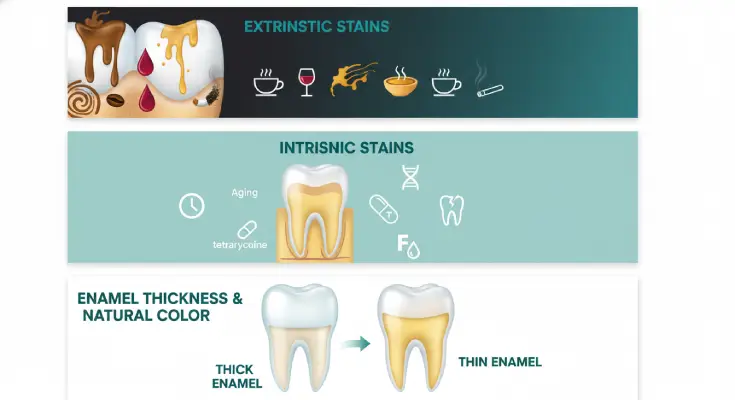
Extrinsic Stains (Surface-Level Stains You Pick Up Daily)
These stains sit on the outer layer of your enamel and are usually caused by everyday habits, like:
- Coffee, tea, iced coffee
- Red wine
- Cigarettes or vaping
- Spicy curries and tomato-based foods
- Dark sodas
- Poor or inconsistent oral hygiene
The good news? These stains are the easiest to treat. Whitening toothpaste, whitening strips, or a professional dental cleaning can noticeably brighten your smile. If you’ve ever wondered how can you whiten your teeth fast, treating extrinsic stains is the quickest win.
Intrinsic Stains (Deeper, Internal Discoloration)
Intrinsic stains are a bit more stubborn because they form inside the tooth. They can happen due to:
- Natural aging (dentin gets more yellow with time)
- Genetics
- Certain childhood medications (like tetracycline)
- Trauma or injury to a tooth
- Excess fluoride during childhood
Since these stains are deeper, DIY methods usually won’t work. Professional whitening or, in more severe cases, bonding or veneers may be the best way to whiten your teeth if intrinsic staining is the cause. For guidance on maintaining overall tooth health and addressing underlying issues that can affect discoloration, you can check out how to help a toothache.
Enamel Thickness & Natural Color
Some people naturally have thinner enamel, which makes the yellowish dentin underneath more visible. No amount of “hack” or home remedy can change this, it’s just biology. This is also why not everyone can achieve that super bright Hollywood-white shade.
Understanding these causes helps you make smarter choices about how you can make your teeth white and which whitening methods will actually work for your smile.
How Teeth Whitening Works (Very Simple Science)
Before you start searching for the best way to whiten your teeth, it helps to understand what whitening actually does. The science sounds complicated, but the process is surprisingly simple.
Most effective whitening methods, whether it’s professional treatment or at-home kits, use hydrogen peroxide or carbamide peroxide. These ingredients release tiny oxygen molecules that gently break apart the stains trapped inside your teeth. That’s how whitening gels brighten your smile from the inside out, not just on the surface.
And here’s something a lot of people get wrong: Whitening does NOT damage enamel when used correctly. This is one of the most common myths, and it scares people away from methods that genuinely work.
On the other hand, popular “natural hacks” like charcoal, lemon, or baking soda scrubs don’t actually whiten your teeth. They’re just abrasive, meaning they physically scrape your enamel, and over time, that can make your teeth look more yellow, not whiter.
One more important thing to know: Veneers, crowns, caps, and fillings don’t whiten. So depending on your dental work and the material used for your dental crowns, your results may vary, no matter which method you try.
Understanding this basic science helps you choose the safest, most effective solutions when you’re wondering how you can whiten your teeth or the best way to get white teeth without harming your smile.
The Best Ways to Whiten Your Teeth (Ranked)
Here’s your complete guide, ranked from most effective to least.
Professional In-Office Teeth Whitening
If you’ve been wondering about the best way to whiten your teeth or how you can whiten your teeth fast, professional in-office whitening is hands down the most effective option. It’s the go-to method for people who want dramatic, immediate results without experimenting with endless home remedies.

How It Works
Your dentist applies a high-strength whitening gel (usually 25%–40% peroxide) and may activate it with a special light. This powerful formula penetrates deep into the tooth and breaks apart stains that have built up over the years, something no home remedy or DIY trick can match.
Results You Can Expect
- 5-8 shades whiter in just 45-90 minutes
- Instant, dramatic brightness
- Long-lasting results (anywhere from 6 months to 3 years)
If you’ve ever wondered how you can make your teeth white quickly, this is the answer.
Pros
- The fastest whitening method available
- Safest because it’s done under professional supervision
- Perfect for weddings, events, or photo-ready moments
Cons
- More expensive than at-home options
- Some people experience temporary sensitivity
Cost
₹12,000–₹25,000+, depending on your clinic and city.
Dentist-Prescribed At-Home Whitening Kits
If you’re looking for the best way to whiten your teeth without paying the full price of in-office treatment, dentist-prescribed at-home whitening kits are the perfect middle ground. They’re stronger and more reliable than store-bought strips, but still convenient enough to use at home.

How It Works
Your dentist creates custom-fitted trays and gives you professional-grade peroxide whitening gels. You simply wear the trays for 30–60 minutes a day for 1–3 weeks, depending on how white you want your teeth.
Results You Can Expect
- 4–6 shades whiter
- A natural, even brightness
- Long-lasting whitening that outperforms most DIY methods
For people wondering how they can whiten their teeth safely while still getting strong results, this option checks all the boxes.
Pros
- Stronger and more effective than over-the-counter strips
- Custom-fit trays prevent gel leakage and gum irritation
- More affordable than in-office whitening
- Great for anyone searching for the best way to get white teeth at home
Cons
- Takes consistent daily use
- Some people may experience temporary sensitivity
Cost
₹8,000–₹15,000
Best For
Anyone who wants deep, safe, dentist-approved whitening without spending as much as an in-office treatment. If you’ve been asking how you can make your teeth white in a controlled, predictable way, this method is a solid choice.
Over-the-Counter Whitening Strips
If you’re looking for an easy and affordable teeth whitening option, whitening strips are honestly one of the best at-home solutions. They use a peroxide-based gel that sits on your teeth for about 20–30 minutes, helping break down surface stains without much effort.
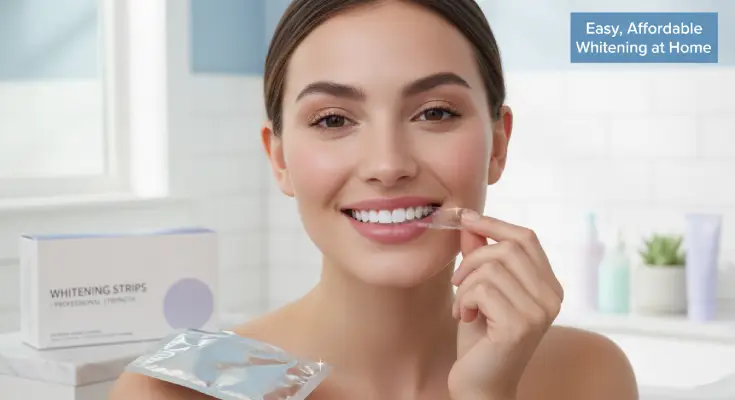
How They Work
You simply apply the gel-coated strips to your teeth, let them sit, and peel them off. That’s it. With consistent use, most people see their teeth get 2-4 shades whiter within 7-14 days, perfect for mild to moderate staining from coffee, tea, or everyday habits.
Results
- Subtle but noticeable whitening
- Works steadily over a couple of weeks
- Great entry-level whitening option
Pros
- Super affordable
- Very easy to use
- You’ll see visible results
Cons
- Not as powerful as professional whitening
- Can cause temporary sensitivity
- Doesn’t work as evenly on crooked teeth because the gel doesn’t spread perfectly
Cost
₹1,000–₹4,000 depending on the brand.
Best For
Anyone who wants budget-friendly teeth whitening with solid, predictable results, without visiting the dentist.
Whitening Toothpaste (Maintenance, Not Real Whitening)
Whitening toothpaste is a good add-on to your routine, but it’s important to know what it can and can’t do. These toothpastes don’t actually whiten the natural color of your teeth, instead, they help remove surface stains from things like coffee, tea, or everyday plaque buildup.
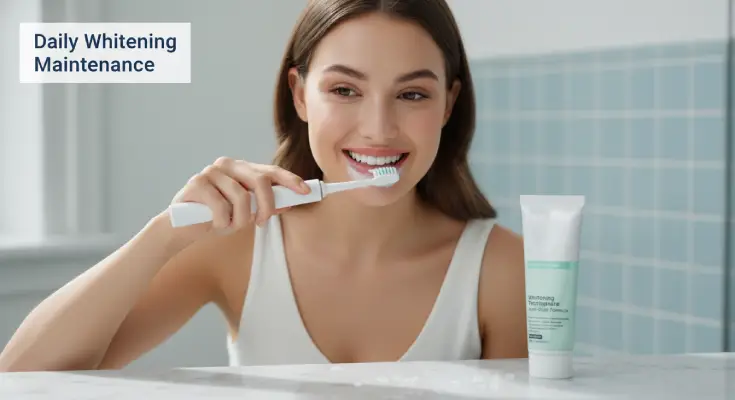
How It Works
They use mild abrasives or gentle chemical stain removers to polish away those surface stains and keep your smile looking fresh.
Pros
- Perfect for everyday maintenance
- Helps prevent new stains from forming
Cons
- Won’t change the natural shade of your teeth
- Can lighten only about 1 shade at best
Cost
₹150–₹400
Best For
Maintaining your whitening results after using strips, dentist kits, or in-office treatments.
LED Whitening Kits (More marketing than science)
LED teeth-whitening kits look high-tech, but here’s the truth: the LED light itself doesn’t whiten your teeth. The real whitening happens because of the peroxide gel that comes with the kit. The light may help speed up the reaction a tiny bit, but the difference is usually minimal.

Pros
- Generally safe to use
- Can give mild whitening results
Cons
- Often overpriced for what they actually do
- The LED light doesn’t whiten, the peroxide gel does
Best For
People who like the “techy” whitening experience and want subtle results, not a dramatic shade change.
Natural Home Remedies (Which Are Safe & Which Are NOT)
When it comes to natural teeth-whitening hacks, the internet is full of “miracle tricks.” But most of them don’t work, and some can actually damage your enamel permanently. Here’s the truth:
Baking Soda
Baking soda can help remove surface stains and make your teeth look slightly brighter. It’s safe if you use it once a week, but remember, this is NOT a bleaching method. The results are mild and purely from gentle abrasion, not real whitening.
Activated Charcoal
Charcoal may look trendy, but it’s highly abrasive. Regular use can wear down enamel, making your teeth more yellow in the long run. Dentists strongly advise against it for whitening.
Oil Pulling
Swishing coconut oil may help with gum health and bacteria control, but scientifically, it has zero whitening effect. It won’t lighten stains or change your natural shade.
Lemon, Vinegar, Apple Cider Vinegar
These acidic ingredients can strip enamel, increase sensitivity, and cause irreversible damage. They might make teeth feel “smoother,” but that’s actually enamel erosion, not whitening.
Turmeric, Banana Peel, and Other Viral Hacks
There’s no scientific evidence that rubbing peels, spices, or powders can whiten teeth. These hacks are harmless, but they don’t do anything.
The Best Whitening Method for YOU (Personalized Guide)
Choosing the right teeth-whitening option doesn’t have to be confusing. Here’s a quick and clear breakdown so you can pick what actually fits your goals, budget, and tooth condition:
If you want FAST results
Go for in-office teeth whitening. It’s the quickest and most powerful way to brighten your smile, especially before a wedding, photoshoot, or big event.
If you want EFFECTIVE + AFFORDABLE
Choose whitening strips. They’re budget-friendly, easy to use, and can noticeably lighten mild to moderate stains.
If you want DEEP, LONG-LASTING whitening
Dentist-prescribed custom whitening trays are your best bet. They use professional peroxide gels to target deeper stains and deliver even, natural-looking results.
If you have SENSITIVE teeth
Look for low-peroxide whitening gels and use a sensitivity toothpaste containing potassium nitrate. This helps reduce irritation while still giving you gradual whitening.
If you have fillings, veneers, crowns, or caps
Whitening will NOT change the color of these restorations. For an even smile, you may need bonding or veneers instead.
How Long Do Whitening Results Last?
| Whitening Method | Expected Duration | Notes |
|---|---|---|
| In-office professional whitening | 1–3 years | Longest-lasting and most effective way to whiten your teeth |
| Dentist-prescribed custom trays | 1–2 years | Deep, even whitening with professional peroxide gels |
| Whitening strips | 3–6 months | Budget-friendly at-home whitening; great for mild stains |
| Whitening toothpaste | Ongoing maintenance | Helps maintain results after professional or at-home whitening |
Whitening Safety: What Dentists Want You to Know
If you’re wondering how you can whiten your teeth safely, it’s important to separate fact from myth. The good news is that teeth whitening is generally safe, as long as you use the right products and follow instructions.
Whitening Is Safe When Done Correctly
Modern peroxide-based whitening gels, whether in-office, dentist-prescribed trays, or even at-home strips, do not damage enamel when used as directed. So, if you’re looking for the best way to whiten your teeth without harming them, professional guidance or properly formulated at-home options are your safest bet.
Over-Whitening Can Be Harmful
Using whitening strips or gels excessively, for example, daily for months, can backfire. Potential side effects include:
- Enamel thinning – making teeth more prone to stains and sensitivity
- Sensitivity – discomfort to hot, cold, or sweet foods
- Gum irritation – redness or soreness
Whitening During Pregnancy
Most dentists recommend avoiding peroxide-based whitening treatments while pregnant. Though generally safe for most adults, it’s better to wait until after pregnancy to lighten your smile.
Best Habits to Keep Your Teeth White (Science-Backed)
Once you’ve figured out the best way to whiten your teeth, the next step is keeping your smile bright for the long haul. These simple, science-backed habits can help maintain your results and prevent new stains.
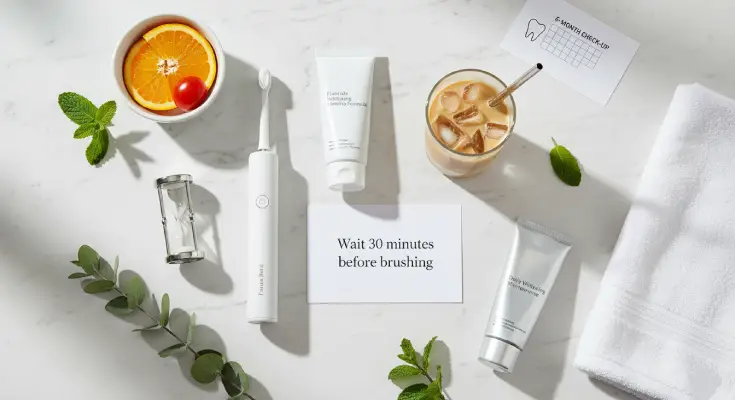
1. Brush Twice Daily with Fluoride Toothpaste
Regular brushing removes plaque and surface stains. Using fluoride toothpaste also strengthens enamel, keeping your teeth healthy while maintaining their brightness.
2. Rinse After Coffee, Tea, or Dark Drinks
If you love your morning coffee or afternoon tea, rinse your mouth with water afterward. This helps wash away pigments that can settle on your teeth and dull your whitening results.
3. Use a Straw for Iced Drinks
Sipping iced coffee, tea, or dark sodas through a straw reduces contact between the liquid and your teeth, helping prevent surface stains.
4. Avoid Brushing Right After Acidic Foods
Foods like citrus or tomato-based dishes temporarily soften enamel. Wait at least 30 minutes before brushing to avoid enamel erosion.
5. Schedule Professional Cleanings Every 6 Months
Regular dental cleanings remove stubborn plaque and tartar. This not only supports oral health but also keeps your teeth looking brighter.
6. Limit Tobacco, Wine, and Dark Sodas
These are some of the biggest culprits behind yellowing teeth. Cutting back or moderating consumption can significantly prolong your whitening results.
7. Use Whitening Toothpaste for Maintenance
Once you’ve achieved your desired shade, whitening toothpaste is perfect for daily maintenance. It removes surface stains and helps preserve the effects of your whitening treatments.
8. Drink Plenty of Water
Hydration keeps your mouth clean and encourages saliva production, which naturally protects teeth from stains and decay.
Whitening Alternatives for Stubborn Stains
Sometimes, even the best way to whiten your teeth at home or in the dentist’s office isn’t enough. Deep, intrinsic stains, like discoloration from aging, medications, or trauma, may not respond to traditional whitening methods. In these cases, there are reliable alternatives that can give you a bright, confident smile.
1. Dental Bonding
Dental bonding involves applying a thin layer of tooth-colored resin to the surface of your teeth. This effectively masks stains and discoloration, giving your smile a uniform, bright appearance. It’s a less invasive and more affordable option compared to veneers, and it can be completed in a single dental visit.
2. Porcelain Veneers
Porcelain veneers are thin shells custom-made to cover the front surface of your teeth. They can provide a Hollywood-white, long-lasting smile and are ideal for people with stubborn discoloration, chipped teeth, or uneven shapes. While more expensive, veneers offer dramatic results and are highly durable.
3. Internal Bleaching
For teeth that have darkened after a root canal, internal bleaching is an effective solution. The whitening agent is applied inside the tooth, directly targeting the discoloration from within. This method can restore the natural color of the tooth without affecting surrounding teeth.
Conclusion
If you’ve been wondering, “What’s the best way to whiten your teeth?”, you now have a clear, science-backed roadmap. Achieving a bright, confident smile isn’t about chasing viral hacks or harsh home remedies; it’s about choosing safe, proven methods that actually work.
For those seeking fast and dramatic results, professional in-office whitening is the top choice. It delivers noticeable changes in just one session and is ideal for special events or when you need an instant glow.
If you prefer a long-lasting, deep whitening solution, dentist-prescribed custom trays are a fantastic option. They target stubborn stains more effectively than over-the-counter products, giving you an even, natural-looking whiteness that can last for years with proper care.
For affordable at-home results, whitening strips are a reliable choice. They work well on mild to moderate surface stains, helping you gradually brighten your teeth without breaking the bank.
Finally, maintaining your results is just as important as the whitening method itself. Daily habits such as brushing twice a day with fluoride toothpaste, rinsing after coffee or tea, limiting tobacco or dark sodas, and occasionally using whitening toothpaste can keep your smile radiant for months.
With the right approach, combining safe whitening methods and consistent oral care, a whiter, brighter smile is completely achievable. You can finally feel confident showing off your teeth, knowing your smile is healthy, natural, and stunning.
FAQs
1. What’s the best way to whiten your teeth?
The best way depends on your goals. For fast, dramatic results, professional in-office whitening works best. For deep, long-lasting results, dentist-prescribed custom trays are ideal. For budget-friendly at-home whitening, strips are a great choice.
2. How can I make my teeth white at home?
At-home options include whitening strips, dentist-prescribed trays, and whitening toothpaste for maintenance. Avoid harsh hacks like lemon or charcoal; they can damage enamel.
3. How long does teeth whitening last?
It depends on the method: in-office whitening can last 1–3 years, custom trays 1–2 years, whitening strips 3–6 months, and toothpaste helps maintain results daily. Drinks like coffee, tea, red wine, and smoking can shorten results.
4. Are teeth whitening products safe?
Yes, when used correctly. Modern peroxide-based whitening gels do not damage enamel. Overuse or daily prolonged use can cause sensitivity, enamel thinning, or gum irritation.
5. Can I whiten teeth with fillings, veneers, or crowns?
No, whitening won’t change the color of fillings, veneers, or crowns. If you have restorations, consult your dentist about alternatives like bonding or veneers for a uniform, bright smile.
6. Can I whiten teeth naturally at home?
Some natural methods like baking soda can remove mild surface stains, but most viral hacks (lemon, charcoal, turmeric, banana peel) don’t whiten teeth and can harm enamel.
7. Is teeth whitening safe during pregnancy?
Dentists generally advise avoiding peroxide-based whitening treatments during pregnancy to be on the safe side.

Dr. Alexander Heifitz (Author)
Dr. Alexander Heifitz is the founder of 65 Broadway Dental in NYC, where he combines advanced dental expertise with a patient-first approach. He specializes in cosmetic and restorative treatments such as dental implants, veneers, Invisalign, and smile makeovers, helping New Yorkers achieve both oral health and confidence.
Booking An Appointment
Looking for a reliable dentist in Downtown NYC? Whether you need a routine cleaning, urgent care, or a full smile transformation — we’ve got you covered. We accept most PPO insurance plans and offer flexible scheduling.
+1 (212) 430-3888
Call for appointment
Walk-ins Welcome / Same-Day Appointments Available

Related Blogs
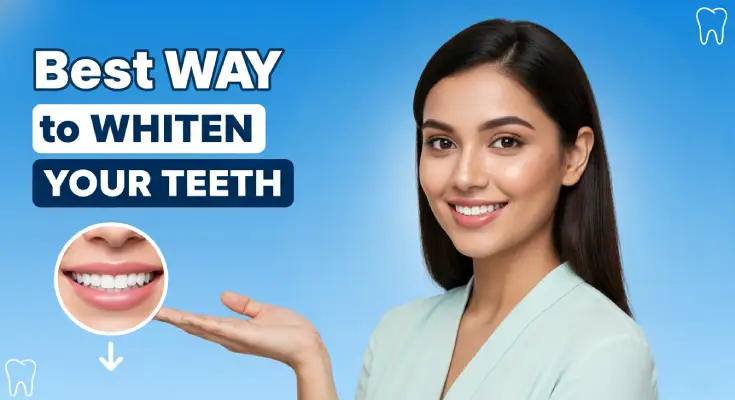
The Best Way to Whiten Your Teeth: Proven Methods That Actually Work
Discover the best ways to whiten your teeth safely. Learn proven methods, dentist-recommended treatments, and tips to get a brighter, long-lasting smile.
Read More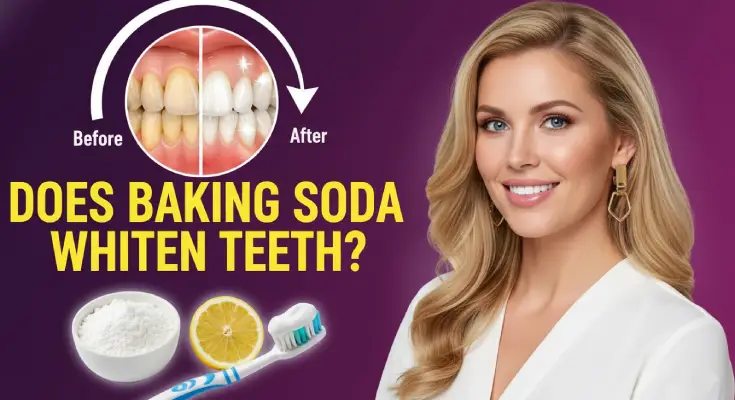
Does Baking Soda Whiten Teeth? The Complete Evidence-Based Answer
Discover how baking soda can naturally brighten teeth, what results to expect, and the science behind its whitening effect.
Read More